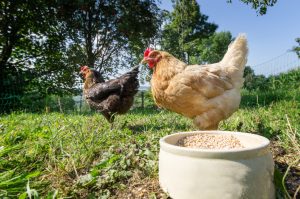Chickens are omnivores, which means that they eat both plants and animals. Well, mainly insects rather than animals. Although chickens have a need for protein sourced from animal tissue, they also need plants to eat.
If your chickens are able to get out of the coop and forage, then they’ll have access to grass, seeds and other plants. But what if your chickens can’t leave the coop?
Fodder is a cheap and easy way to get your flock the plants that they need to stay healthy. Growing fodder is simple and requires minimal time, work and equipment.

What is fodder?
Fodder is a fancy term that simply means food given to animals that they didn’t forage for themselves. Technically, it could be grains, hay, etc. When you talk about fodder for chickens though, most people consider it the greens from sprouted grains.
Grains are healthy for chickens, but turning the grains into fodder makes more sense. When you allow the grains to sprout, the nutrients in the grains multiplies, essentially for free. All you have to do is let the grains sprout.
If you’re familiar with how chickens digest their food, you’ll know that they rely on small pieces of grit to grind up their food, including grains, in their digestive system. Grains are especially tough and can be hard to digest. If the same, tough grain is sprouted, it becomes 40% more digestible. So not only will the fodder have more nutrients than the grain itself, now those nutrients are more accessible than before because the chicken can digest them easier.
What is the best fodder for my chickens?
You can sprout many different types of grains for your chickens. The easiest and most nutritious for your flock are:
- Whole grain wheat
- Barley
- Rye
- Oats
You could also sprout sunflower seeds, lentils, alfalfa or other grains, but wheat, barley, rye and oats are the easiest to find, sprout and provide the best nutritional value for your chickens.
How to Grow Fodder for Chickens
Growing fodder for your chickens is really simple. In a nutshell, you’re going to soak the grains overnight, drain the water off and then keep them moist for a few days. Let’s talk about it in a little more detail.
- The first step is to soak your grains overnight. You’ll want to do this in a shallow plastic container. My favorite container to use is a cheap cat litter box, the kind without a top part, that you can grab for a couple of bucks at the dollar store. The grains need to be about ½” deep in the pan. This makes it easier to drain excess water off. Place the soaking grains in a place where they’ll be at least room temperature.
- After the grains have soaked overnight, you’ll notice that they have started to crack open and sprout. Carefully drain all of the water out. You can drain them over a mesh sieve at this point.
- Once the water has drained off, place them back into the shallow pan that they were in the night before. From this point on, you’ll want to keep your grains moist, but not soggy. To do this, you’ll rinse the grains with clean, fresh water twice a day and drain them.
- In the beginning, you will need to drain the grains over a mesh sieve. As the roots grow, the fodder will create an entangled mat, making it easier to rinse them. Once the grains are matted nicely, you can rinse the grains and then flip the pan onto it’s side, holding the grains with your hand to prevent the mat from coming out.
- The grains, or fodder now, is ready to feed to your chickens at any point. Sprouted grains are healthy for your chickens, so you can feed them as soon as you’d like. However, the nutritional value of fodder maxes out when the fodder is 4-5” tall.
Once your fodder has grown, simply toss the entire mat, or cut portions of it, into the coop for your chickens. They will eat the entire plant, including the roots.
Growing fodder is an excellent way to give chickens greens when they otherwise wouldn’t be able to get it.